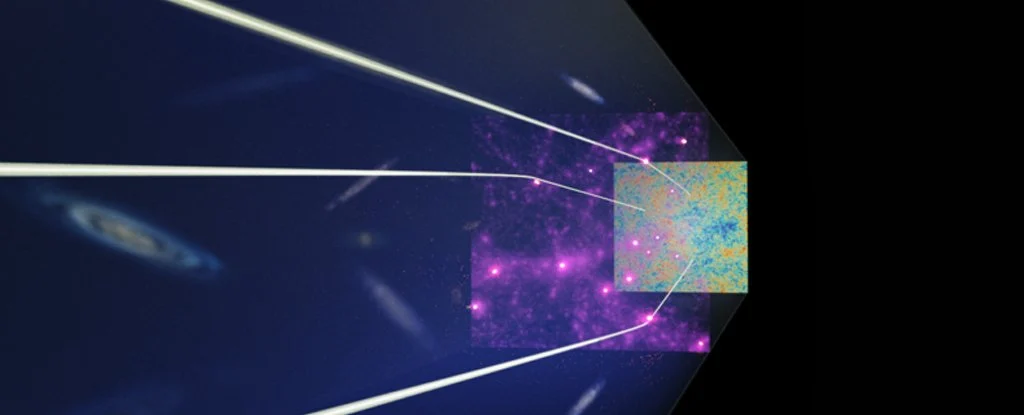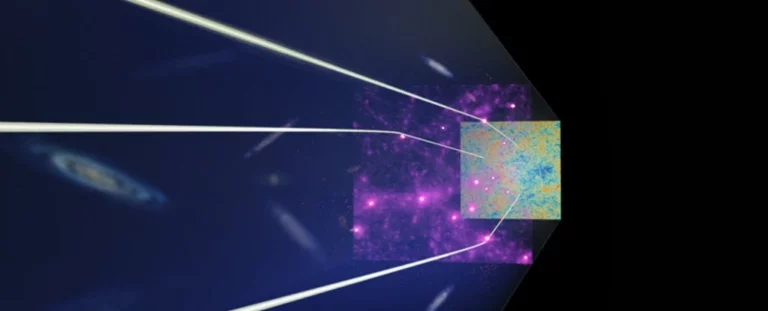Scientists Catch a Glimpse of the Universe’s Earliest Dark Matter
Calculations based on the light of nearby galaxies have allowed us to learn what little we do about dark matter. However, when we look farther away, the starlight becomes darker, making it more difficult to discern the delicate effect of this most enigmatic of forces.
By examining how murky dark matter masses distort the cosmic background glow, a team of astronomers from the US and Japan have discovered a new technique to shed light on the distant darkness.
Our Universe’s whole history is strewn across the void of space like images thrown from a moving automobile. All we need to do is keep staring down the roadway to observe a series of historic moments.

Unfortunately, the exponential growth of everything hasn’t been kind to those earlier photographs, extending their starry palettes to the point where they’re so depleted of energy that we can only see blazing embers.
Shame we can’t see them for what they really are. If those early galaxies are anything like the ones we observe far later in the history of the Universe, then pockets of gravity created by unknown sources should have an impact on their structural makeup.
It only has the name “dark matter” since it doesn’t emit any information about its nature. Most likely, it’s some form of mass that resembles a neutrino but has few features. It’s possible that it reflects an error in our understanding of how space and time are formed.
The short of it is that we still lack a clear hypothesis for how this event fits into the realm of known physics. Therefore, obtaining a precise measurement of how those really old dark matter haloes emerged will at least let us to determine whether they have evolved through time.
By seeing their dim light, we cannot calculate their overall mass, which includes both visible and luminous components. However, it is feasible to make use of the way that their bulk causes the starlight that passes through their surrounding area to be twisted.
With regard to massive clusters of galaxies seen between 8 and 10 billion years ago, this lensing approach is effective enough. However, there is less star radiation in the background to examine for distortions the further back we want to go.
Another light source we may employ is the cosmic microwave background, claim Hironao Miyatake and colleagues at Nagoya University (CMB).
Consider the CMB to be the very first image of the universe. The faint radiation that was the echo of light that was discharged when the universe was about 300,000 years old today pervades space.
Researchers explore a variety of theories on the first crucial stages in the evolution of the universe using minor patterns in this background hum. However, it was a first to use it to determine the distribution of dark-matter haloes encircling distant galaxies and their average mass.
“It was an absurd notion. Nobody was aware that we could achieve this, “says University of Tokyo astronomer Masami Ouchi.
But Hironao told me after I delivered a lecture about a sizable sample of far-off galaxies that it would be feasible to use the CMB to look at the dark matter around these galaxies.
Hironao and his associates concentrated on a particular kind of far-off star-forming objects known as Lyman-break galaxies.
They examined patterns in the microwave radiation as observed by the Planck satellite of the European Space Agency using a sample of roughly 1.5 million of these objects obtained by the Hyper Suprime-Cam Subaru Strategic Program survey.
The findings gave the researchers an idea of the normal halo mass for galaxies that existed close to 12 billion years ago, a time that was much different from the one we observe here on Earth today.
The conventional cosmological theory holds that the spatial fluctuations that magnified the clumping of matter were a major factor in the development of those early galaxies. It’s interesting that these new measurements of the early galactic masses show a lower level of matter clumping than is predicted by the theories that are now in vogue.
Miyatake states that “our finding is still questionable.” The model would appear to be defective the further back in time you go, assuming it were true.
Existing theories on how newly baked components came together to create the earliest galaxies may have gaps that can be filled in to help explain the beginnings of dark matter.
Even if the Universe’s infant photographs are fading, it is obvious that they still have a lot to say about how we came to be.
This research was published in Physical Review Letters.
Source: ScienceAlert
Do not forget to share your opinion with us to provide you with the best posts !




0 Comments